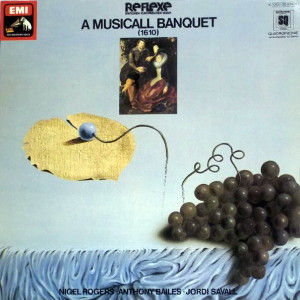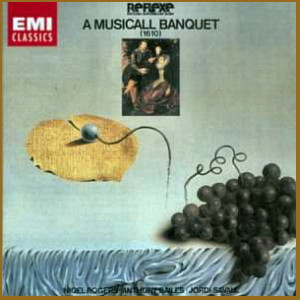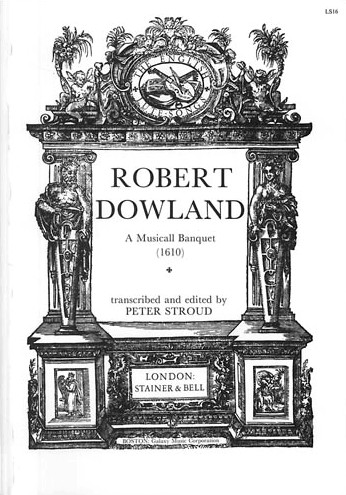 |
1 LP -
1C 063-30 934 Q - (p) 1977
|

|
| 1 CD - 8
26502 2 - (c) 2000 |
 |
| 1 CD -
CDM 7 63429 2 - (c) 1991 |
|
A MUSICALL
BANQUET (1610) - Robert Dowland
|
|
|
|
|
|
| - Sir Robert
Sidney His Galliard (John
Dowland, 1563-1626) |
2' 17" |
|
| - My heavie
sprite, oppress'd with sorrow's
might (Antony Holborne,
?-1602) - Text: George, Earl of
Cumberland |
2' 04" |
|
| - Change thy
mind since she doth change
(Richard Martin, 1570-1618) - Text:
Robert Devereux, Earl of Essex |
2' 52" |
|
| - O Eyes, leave
off your weeping (Robert
Hales, ?-1616) - Text: Nicholas
Breton? |
3' 04" |
|
| -
Go, my flock, go get you hence
(Anonym) - Text: Sir Philip
Sidney |
3' 18" |
|
| - O dear life,
when shall it be? (Anonym) - Text:
Sir Philip Sidney |
2' 15" |
|
| - To plead my
faith (Daniel Batchelar, ?-?)
- Text: Robert Devereux, Earl of
Essex |
2' 26" |
|
| - In a grove
most rich of shade
((Guillaume) Tessier, ?-?) - Text:
Philip Sidney |
2' 28" |
|
| - Far from
triumphing court (John
Dowland, 1563-1626) - Text: Sir
Henry Lea |
3' 36" |
|
| - Lady, if you
so spite me (John Dowland,
1563-1626) - Text: Anonym |
2' 11" |
|
| - In darkness
let me dwell (John Dowland,
1563-1626) - Text: Anonym |
3' 06" |
|
|
|
|
| - Si le parler et le silence
(Pierre Guédron, 1565?-1621) - Text:
Anonym (Air du Cour) |
3' 07" |
|
| - Ce penser qui sans fin
tirannise ma vie (Anonym) - Text:
Anonym (Air du Cour) |
4' 29" |
|
| - Vous que le Bonheur
rappelle (Pierre Guédron,
1565?.1621) - Text: Anonym (Air du
Cour) |
2' 23" |
|
| - Passava Amor su arco
desarmado (Anonym, Spanien) - Text
aus Jorge du Montemayors "Diana" |
1' 31" |
|
| - Sta notte mi sognava
(Anonym, Italien) - Text: Anonym |
1' 56" |
|
| - Vuestros ojos tienen
d'Amor (Anonym, Spanien) - Text:
Anonym (Spanien) |
1' 07" |
|
| - Se di farmi morire
(Domenico Maria Megli, ?-?) - Text:
Anonym |
1' 23" |
|
| - Dovrò dunque morire?
(Giulio Caccini, um 1550-1610) - Text:
Anonym |
1' 47" |
|
- Amarilli mia bella
(Giulio Caccini, um 1550-1610) - Text:
Giulio Caccini
|
3' 58" |
|
| - O
bella più (Anonym, Italien)
- Text: Anonym |
1' 21" |
|
|
|
|
| Nigel Rogers,
Tenor |
|
| Anthony Bailes,
Laute |
|
| Jordi Savall,
Viola da Gamba |
|
|
|
|
|
Luogo
e data di registrazione |
|
Evagelische
Kirche, Séon (Svizzera) - 6-7
settembre 1976 |
|
|
Registrazione: live /
studio |
|
studio |
|
|
Producer / Engineer |
|
Gerd
Berg / Johann-Nikolaus Matthes
|
|
|
Prima Edizione LP |
|
EMI
Electrola "Reflexe" - 1C 063-30
934 Q - (1 lp) - durata 54' 27" -
(p) 1977 - Analogico
(Quadraphonic) |
|
|
Prima Edizione CD |
|
EMI
"Classics" - CDM 7 63429 2 - (1
cd) - durata 54' 27" - (c) 1991 -
ADD |
|
|
Edizione CD |
|
EMI
"Classics" - 8 26502 2 - (1 cd) -
durata 54' 27" - (c) 2000 - ADD |
|
|
Note |
|
- |
|
|
|
|
|
 A note about
aspects of ornamentation of
the songs A note about
aspects of ornamentation of
the songs
The song Amarilli mia
bella is the best known
of Giulio Caccini’s Le
Nuove Musiche, published
in 1602, and remains one of
the few italian monodies to
survive in popular use to this
day, it still being a
favourite in singers’ debut
recitals. It must have already
been well known in England by
1610 for Robert Dowland to
include it in his Musicall
Banquet.
The version performed on this
recording is neither Caccini’s
original song with figured
bass for chitarrone
accompaniment, nor Robert
Dowland’s realisation in lute
tablature, as presented in his
Musicall Banquet, but
an ornamented in sion of the
melody with the accompaniment
in tablature for the bass viol
from an original MS in
the British Museum (Egerton
2971). This version seemed
interesting enough to be
included in this recording at
the risk of being the only
song where we have departed
from Dowland’s printed version
and gone beyond the normal, "standard" (if,
in fact there was such a thing
at the time) embellishment of
it. This MS
copy must have belonged to a
highly competent professional
singer, and represents what
might have been a professional
singer's approach to the song.
There are already several
recordings of the song either
completely or almost
completely unembellished, so
perhaps this very ornate
version will help restore the
balance.
No.7 of the collection, To
plead my faith by Daniel
Batchelar also exists in an
ornamented version in Giles
Earle’s Song Book (1613). His
version is sufficiently
different from Batchelar’s
original for it not to merit
inclusion in a recording of
the Musicall Banquet
but I have attempted to
incorporate at least some of
the ornamentation that Earle,
a professional singer of the
day, put and on the Italian
treatises of Caccini,
Bovicelli, into the song,
without its becoming
unrecognis-Ornamentation in
general on this record has
been spread to England by
1610.
Able as
the song Batchelar wrote.
Conforto etc. whose influence
had certainly
Nigel
Rogers
Brief notes on the English
lute song
"I have also set them
tablature-wise to the lute in
the Cantus book for one to
sing and play alone when your
Lordship would retire yourself
and be, more private." So
wrote Thomas Morley in
dedicating his Canzonets
or Little Short Aers to Five
and Sixe Voices to Sir
George Carey in 1597. In these
canzonets Morley had simply
intabulated the lower parts
for lute. Other composers were
quick to refine this method in
order to make a more idiomatic
lute part. The quick decay of
the lute's sound meant that
long notes needed to be
repeated or ornamented, and
chords arpeggiated to
compensate for this. Any
competent lutenist would have
done such things
automatically, and it is not
surprising to find that, with
the exception of Morley, all
the lute song composers were
themselves players. A further
innovation (mentioned in the
title page of most of the
books from 1600 onwards) was
the addition of bass viol to
strengthen the bass line.
Where singer and lutenist were
not one and the same person it
became usual to demand more
from each part, and in many of
the later lute songs a more
independent role is given to
the lute. When the bass viol
is present, it too often has
an independent part in the
form of a second bass line
(the lute playing the other).
This can be heard in Dowland's
In darkness let me dwell,
perhaps the finest example of
the 'song to the lute and
viol'. Of course not all the
lute songs have this
complexity; some have a simple
chordal accompaniment such as
would have been playable by
any singer-lutenist of the
time, and they are very
pleasing in their own way.
Robert Dowland's Musicall
Banquet is unique among
English publications for lute
and voice: the only one to
contain English, French,
Spanish, and Italian airs, it
is truly a banquet! Whereas
most of the English songs have
either a contrapuntal or a
chordal accompaniment, almost
all the foreign songs have
chordal accompaniments that
tend to move note-for-note
with the vocal line. The
Italian songs reflect the (for
many English lutenists) new
basso-continuo accompanying
style. Dowland, however,
realising that most of his
public would be amateurs and
unfamiliar with the new way,
intabulated a continuo part
for the lute.
On this recording we have also
made use of the bass viol
'after the leero [lyra] way'
to accompany two of the songs.
Robert Jones and John Coprario
offer this method of
accompaniment as an
alternative to the lute, as
does the eccentric Tobias
Hume. In O dear life
Jordi Savall has followed
Captain Hume's advice to "play
one straine with your fingers
the other with your Bow, and
so continue to the end".
Anthony
Bailes
|
|
|
EMI Electrola
"Reflexe"
|
|
|
|

